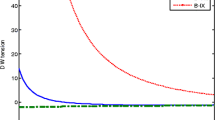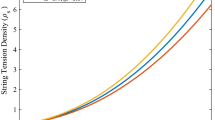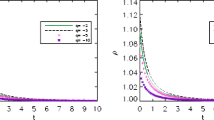Abstract
We have studied the plane symmetric cosmological solutions for quark mattercoupled with the string cloud and domain walls in the context ofRosen’s (General Relativity and Gravitation 4:435, 1973) bimetrictheory. It is observed that, in this theory, string cloud and domain wallsdo not exist. As we know that, at the early stage of evolution of theuniverse, domain walls as well as cosmic strings do appear which lead to theformation of galaxies. Thus, it may be said that the bimetric relativitydoes not help to describe the early era of the universe.
Pacs
04.50+h
Similar content being viewed by others
Avoid common mistakes on your manuscript.
Introduction
Rosen [1] formulated a bimetric theory of gravitation which satisfies theprinciples of covariance and equivalence. He has modified the formalism of thegeneral relativity theory introducing into it, besides the metric tensor g ij associated with the line element
a second metric tensor corresponding to flat space-time described by the line element
at each point of the space-time. The tensor g ij describes gravitation and interacts with matter. The back ground metricγ ij refers to inertial forces. The theory also agrees with present-dayobservational facts pertaining to general relativity. The field equations ofRosen’s bimetric theory of gravitation derived from variational principles are
where
and
A vertical bar (|) denotes the covariant differentiation with respect toγ ij , and is the energy momentum tensor of the matter field. With the adventof new theories of gravitation, it has been a common practice to investigate severalaspects of the new theories and then compare them with the results ofEinstein’s theory of gravitation. With this motivation, a lot of work has beendone in Rosen’s bimetric theory of gravitation. In particular, Mohanty et al. [2] and Mohanty and Sahoo [3] have shown the non-existence of perfect fluid or mesonic perfect fluidmodels in bimetric theory, while Reddy [4] has established the non-existence of Bianchi type string cosmologies inthis theory. Sahoo [5] and Sahoo et al. [6] have studied Kantowski-Sachs and Bianchi type cosmic strings coupled withMaxwell fields in bimetric theory. Recently, Jain et al. [7] have studied axially symmetric space-time with wet dark fluid in bimetrictheory.
The origin of our universe is one of the greatest cosmological mysteries even today.The exact physical situation at early stage of the formation of our universe isstill a subject of study. At the very early stages of evolution of the universe, itis generally assumed that during the phase transition (as the universe passesthrough its critical temperature), the symmetry of the universe is brokenspontaneously. It can give rise to topologically stable defects such as domainwalls, strings, and monopoles [8].
The concept of string theory was developed to describe events of the early stage ofthe evolution of the universe. The general relativistic treatment of strings wasinitiated by Satchel [9]. Moreover, they may act as gravitational lenses and may give rise todensity fluctuations, leading to the formations of galaxies [10]. Strings posses stress energy and are coupled to the gravitational field.There is even a mode describing the gravitation, which is an important reason whystring theory has received so much attention. The gravitational effects of thecosmic strings have been extensively discussed by Vilenkin [10], Gott [11], Letelier [12], and Adhav et al. [13] in general relativity. Also, Tikekar et al. [14] have presented a class of cylindrically symmetric models in stringcosmology. Cosmic strings seem to be the best candidate for being observed, and thepresence of strings in the early universe do not contradict the present-dayobservations.
In particular, the domain walls have become important in recent years fromcosmological standpoint when a new scenario of galaxy formation has been proposed byHill et al. [15]. According to them, the formation of galaxies are due to domain wallsproduced during the phase transitions after the time of recombinations of matter andradiation. Vilenkin [16], Isper and Sikivie [17], Widraw [18], Goetz [19], Mukherji [20], Wang [21], Rahaman et al. [22], Reddy and Subba Rao [23], and Adhav et al. [24] are some of the authors who have investigated several aspects of thedomain walls in general relativity. Rahaman [25] and Rahaman, and Mukherji [26] have discussed plane symmetric domain walls in Lyra [27] geometry.
In this study, we will attach strange quark matter to the string cloud and domainwalls. It is plausible to attach strange quark matter to the string cloud becauseone of such transitions during the phase transitions of the universe is quark gluonplasma (QGP)→hadron gas (called quark-hadron phase transition) when cosmictemperature was T∼200 MeV. The possibility of the existence of quarkmatter dates back to early seventies. Itoh [28], Bodmer [29], and Witten [30] proposed two ways of formation of quark matter: the quark-hadron phasetransition in the early universe and the conversion of neutron stars into strangeone at ultrahigh densities.
Strange quark matter is modeled with an equation of state (EOS) based on thephenomenological bag model of quark matter, in which quark confinement is describedby an energy term proportional to volume. In this model, quarks are thought asdegenerate Fermi gases, which exist only in a region of space endowed with a vacuumenergy density B C (called as the bag constant). In the framework of this model, the quark matteris composed of massless u,d quarks, massive s quarks, andelectrons. In the simplified version of the bag model, assuming quarks are masslessand non-interacting, we then have quark pressure p q =ρ q /3(ρ q is the quark energy density); the total energy density is
but the total pressure is
Yavuz et al. [31] and Yilmaz [32, 33] have studied 5-D Kaluza-Klein cosmological models with quark matterattached to the string cloud and domain walls. Adhav et al. [34, 35] have discussed string cloud and domain walls with quark matter inn-dimensional Kaluza-Klein cosmological model in general relativity andstrange quark matter attached to string cloud in Bianchi type-III space time ingeneral relativity. Khadekar et al. [36] have confirmed their work to the quark matters which attached to thetopological defects in general relativity. Katore and Shaikh [37] have obtained cosmological model with strange quark matter attached tocosmic string for axially symmetric space-time in general relativity. Mahanta et al. [38] have discussed string cloud with quark matter in self-creationcosmology.
The purpose of the present work is to study the plane symmetric cosmological modelsin bimetric theory of gravitation with quark matter coupled to the string cloud anddomain walls. The paper is outlined as follows. In section ‘Field equationsand their solutions for cosmic strings with quark matter’, the field equationsand solutions are obtained for dust quark matter coupled with the string cloud inplane symmetric space-time. In the ‘Field equations and their solutions fordomain walls with quark matter’ section, solutions of the bimetric fieldequations are obtained for strange quark matter coupled to the domain walls in planesymmetric metric. In the ‘Conclusion’ section, concluding remarks aregiven.
Field equations and their solutions for cosmic strings with quark matter
We consider the plane symmetric metric in the form
where α, β and γ are functions ofz and t.
The background flat space-time corresponding to the metric (6) is
The energy momentum tensor for cosmic cloud of strings is given by
where ρ is the rest energy density for a cloud with particle attached tothem, and λ is the tension density of the strings; they are related by
Here, ρ p is the particle energy density. The string is free to vibrate, and differentvibrational modes are seen as different masses or spins. Therefore, we will considerquarks instead of particles in the cloud of strings. In this case, from Equation(9), we get
From Equations (8) and (10), we can write the energy momentum tensor for strangequark matter attached to the string cloud as [31]
where ui is the four-velocity of the string, and xirepresents the direction vector of anisotropy. The string source is along thez-axis which is the axis of symmetry.
Orthonormalization of uiand xi is given as
In co-moving coordinate system, from Equations (11) and (12),
Rosen’s bimetric field equations (3) for the plane symmetric metric (6) withthe help of Equations (7), (11), (12), and (13) becomes
where the suffixes 3 and 4 hereafter, denote ordinary differentiation with respect toz and t, respectively.
The field equations (14) to (17) give the solution
Using solution (18) in Equations (14) to (17), we obtain
Hence, from Equation (19), the vacuum solutions of the field equations in bimetrictheory can be expressed in terms of harmonic functions int−z and t + z;
which represent the stationary plane waves moving with unified velocity to positiveand negative directions. The spatial volume of the model is given by
Field equations and their solutions for domain walls with quark matter
A thick domain wall can be viewed as a soliton-like solution of the scalar fieldequation coupled with gravity. There are two ways of studying the thick domainwalls. One way is to solve the gravitational field equations with an energy momentumtensor describing a scalar field ψ with self-interactions contained ina potential υ(ψ)given by
The second approach is to assume the energy momentum tensor in the form [39]
where ρ is the energy density of the wall, p is the pressurein the direction normal to the plane of the wall, and w i is a unit space-like vector in the same direction.
This perfect fluid form of the domain walls includes quark matter described byρ m =ρ q + B C and p m =p q −B C , and the domain wall tension σ w is given by ρ=ρ m + σ w and p=p m −σ w . Here, we use the second approach to study the thick domain walls with quarkmatter in bimetric theory of gravitation.
In the co-moving coordinate system, we have from (25)
Here, the pressure is taken in the direction of the z-axis. The quantitiesρ and p depend on z and t only.
The field equations (3) of Rosen’s bimetric theory of gravity for the lineelement (6) with (26) take the form
The set of field equations (27) to (30) immediately yields
In view of reality conditions p>0and ρ>0, Equation(31) implies that
When p=0=ρ(vacuum), from equations (27) to (30), we obtainwhich in turn yield the same vacuum solutions given by Equations (20) to (22).
Conclusion
Topological stable objects like domain walls and cosmic strings play a fundamentalrole in the formation of the universe during the early stage of evolution. It isevident from the literature that Einstein’s theory of general relativity hasbeen extensively used to establish the existence of thick domain walls and cosmicstrings. Here, it is shown that plane symmetric universe does not accommodate domainwalls and cosmic strings coupled with quark matter in Rosen’s [1] bimetric theory of relativity. The quark matter is vanish automatically;however, the existence of quark may be possible in this theory. Hence, it isconcluded that bimetric theory does not help in any way to study the gravitationaleffects of thick domain walls and cosmic strings at the early stages of evolution ofthe universe.
Authors’ information
PKS and BM are working as assistant professors in the Department of Mathematics,Birla Institute of Technology and Science-Pilani, Hyderabad Campus, Hyderabad,India.
References
Rosen N: A bi-metric theory of gravitation. Gen. Rel. Grav 1973, 4: 435. 10.1007/BF01215403
Mohanty G, Sahoo PK, Mishra B: On Bianchi type-I mesonic cosmological model in bimetric theory. Astrophys. Space. Sci 2002, 281: 609. 10.1023/A:1015868106122
Mohanty G, Sahoo PK: Some Bianchi type cosmological models in bimetric theory. Czech. J. Phys 2002, 52: 1041. 10.1023/A:1020533532237
Reddy DRK: Non-existence of cosmic strings in bimetric theory of gravitation. Astrophys. Space Sci 2003, 286: 397. 10.1023/A:1026397732469
Sahoo PK: On Kantowski-Sachs cosmic strings coupled with Maxwell fields in bimetricrelativity. Int. J. Theor. Phys 2010, 49: 25. 10.1007/s10773-009-0174-z
Sahoo PK, Mishra B, Ramu A: Bianchi types V and VI 0 cosmic strings coupled with Maxwell fields inbimetric theory. Int. J. Theor. Phys 2011, 50: 349. 10.1007/s10773-010-0531-y
Jain P, Sahoo PK, Mishra B: Axially symmetric cosmological model with wet dark fluid in bimetric theoryof gravitation. Int. J. Theor. Phys 2012, 51: 2546. 10.1007/s10773-012-1134-6
Kibble TWB: Topology of cosmic domains and strings. J. Phys. A 1976, 9: 1387. 10.1088/0305-4470/9/8/029
Satchel J: Thickening the string. I. The string perfect dust. Phys. Rev. D. 1980, 21: 2171. 10.1103/PhysRevD.21.2171
Vilenkin A: Cosmic strings. Phys. Rev. D 1981, 24: 2082. 10.1103/PhysRevD.24.2082
Gott JR: Gravitational lensing effects of vacuum string: exact results. Astrophys. J 1985, 288: 422.
Letelier PS: String cosmologies. Phys. Rev. D 1983, 28: 2414. 10.1103/PhysRevD.28.2414
Adhav KS, Nimkar AS, Naidu RL: Axially symmetric non-static domain walls in scalar-tensor theories ofgravitation. Astrophys. Space Sci 2007, 312: 165. 10.1007/s10509-007-9670-x
Tikekar R, Patel LK, Dadhich N: A class of cylindrically-symmetric models in string cosmology. Gen. Rel. Grav 1994, 26: 647. 10.1007/BF02116954
Hill CT, Schramm DN, Fry JN: Cosmological structure formation from soft topological defects. Comments Nucl. Part Phys 1989, 19: 25.
Vilenkin A: Phys. Lett. B. 1983, 133: 177.
Isper J, Sikivie P: Gravitationally repulsive domain wall. Phys. Rev. D 1984, 30: 712. 10.1103/PhysRevD.30.712
Widraw LM: General-relativistic domain walls. Phys. Rev. D 1989, 39: 3571. 10.1103/PhysRevD.39.3571
Goetz G: The gravitational field of plane symmetric thick domain walls. Math. Phys 1990, 31: 2683. 10.1063/1.528969
Mukherji M: Gravitational fields of cosmic membranes. Class Quantum Gravity 1993, 10: 131. 10.1088/0264-9381/10/1/014
Wang A: Gravitational collapse of thick domain walls: an analytic model. Mod. Phys. Lett. A 1994, 9: 3605. 10.1142/S0217732394003440
Rahaman F, Chakraborti S, Kalam M: Domain wall in Lyra geometry. Int. J. Mod. Phys. D 2001, 10: 735. 10.1142/S0218271801001256
Reddy DRK, Subba Rao MV: Axially symmetric cosmic strings and domain walls in Lyra geometry. Astrophys. Space Sci 2006, 302: 157. 10.1007/s10509-005-9022-7
Adhav KS, Raut VB, Dawande MV: Bianchi type-III cosmic strings and domain walls cosmological model ingeneral relativity. Int. J. Theo. Phys 2009, 48: 1019. 10.1007/s10773-008-9875-y
Rahaman F: Higher dimensional domain wall in Lyra geometry. Astrophys. Space Sci 2002, 282: 625. 10.1023/A:1021185414873
Rahaman F, Mukherji R: Domain walls in Lyra geometry. Astrophys. Space Sci 2003, 288: 389.
Lyra G: Über eine modifikation der Riemannschen geometrie. Math. Zeitschrift 1951, 54: 52. 10.1007/BF01175135
Itoh N: Prog. Theor. Phys. 1970, 44: 291.
Bodmer AR: Collapsed nuclei. Phys. Rev. D 1971, 4: 1601. 10.1103/PhysRevD.4.1601
Witten E: Cosmic separation of phases. Phys. Rev. D 1984, 30: 272. 10.1103/PhysRevD.30.272
Yavuz I, Yilmaz I, Baysal H: Strange quark matter attached to the string cloud in the spherical symmetricspace-time admitting conformal motion. Int. J. Mod. Phys. D 2005, 14: 1365. 10.1142/S0218271805007061
Yilmaz I: Domain wall solutions in the nonstatic and stationary Gödel universeswith a cosmological constant. Phys. Rev. D 2005, 71: 103503.
Yilmaz I: String cloud and domain walls with quark matter in 5-D Kaluza-Kleincosmological model. Gen. Rel. Grav 2006, 38: 1397. 10.1007/s10714-006-0322-1
Adhav KS, Nimkar AS, Dawande MV: String cloud and domain walls with quark matter in n-dimensional Kaluza-Kleincosmological model. Int. J. Theo. Phys 2008, 47: 2002. 10.1007/s10773-007-9644-3
Adhav KS, Nimkar AS, Raut VB, Thakare RS: Strange quark matter attached to string cloud in Bianchi type-III spacetime. Astrophys. Space Sci 2009, 319: 81. 10.1007/s10509-008-9941-1
Khadekar GS, Wanjari R, Ozel C: Domain wall with strange quark matter in Kaluza-Klein type cosmologicalmodel. Int. J. Theor. Phys 2009, 48: 2550. 10.1007/s10773-009-0040-z
Katore SD, Shaikh AY: Cosmological model with strange quark matter attached to cosmic string foraxially symmetric space-time. Int. J. Theor. Phys 2012, 51: 1881. 10.1007/s10773-011-1064-8
Mahanta KL, Biswal SK, Sahoo PK, Adhikary MC: String cloud with quark matter in self-creation cosmology. Int. J. Theor. Phys 2012, 51: 1538. 10.1007/s10773-011-1031-4
Press WH, Ryden BS, Spergel DN: Dynamical evolution of domain walls in an expanding universe. ApJ 1989, 347: 590.
Acknowledgements
We would like to thank referees for their valuable suggestions. Also, PKSacknowledges UGC, New Delhi, India for the financial assistance to carry out theMinor Research Project (grant no.: F.41-1385/2012(SR)).
Author information
Authors and Affiliations
Corresponding author
Additional information
Competing interest
The authors declare that they have no competing interests.
Authors’ contributions
All calculations, derivations of the various results and their verifications werecarried out by PKS and BM. All authors read and approved the final manuscript.
Rights and permissions
Open Access This article is distributed under the terms of the Creative Commons Attribution 2.0 International License (https://creativecommons.org/licenses/by/2.0), which permits unrestricted use, distribution, and reproduction in any medium, provided the original work is properly cited.
About this article
Cite this article
Sahoo, P.K., Mishra, B. String cloud and domain walls with quark matter for plane symmetric cosmologicalmodel in bimetric theory. J Theor Appl Phys 7, 12 (2013). https://doi.org/10.1186/2251-7235-7-12
Received:
Accepted:
Published:
DOI: https://doi.org/10.1186/2251-7235-7-12




